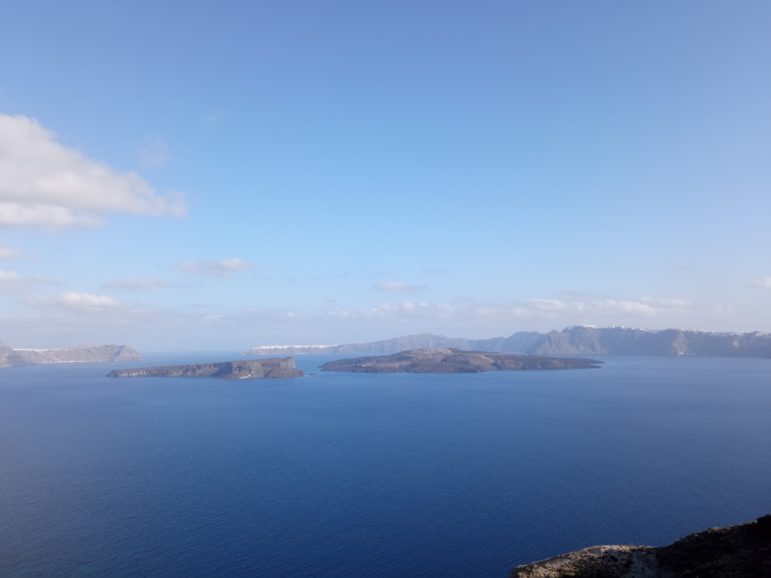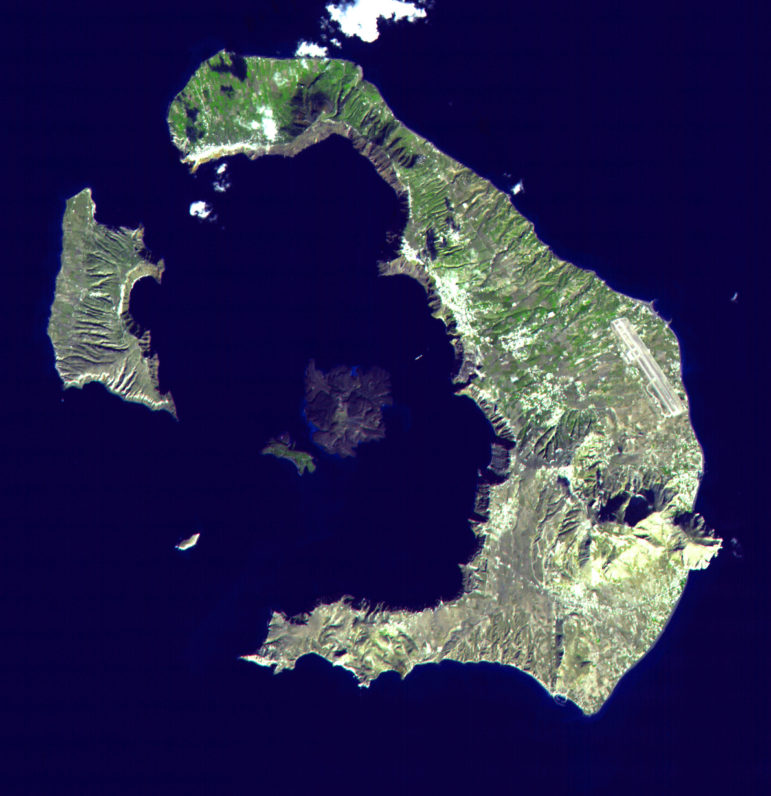TWH – A recent study in PNAS Nexus examined tree rings and sulfur deposits in ice-cores to precisely date volcanic eruptions. It focused on dating the eruption of Thera and other eruptions in the 2nd millennium B.C.E. Pagans have two, and possibly three, reasons to have an interest in this research.
First, volcanic eruptions have triggered sudden, drastic, but short-term, climate-change events. These volcanic climate-change events, volcanic winters, have cooled the planet, not warmed it. Still, they do provide evidence about the impact of climate-change on humans. Volcanic winters have disrupted global weather patterns, leading to famine.

View of the caldera of Thera – Image credit: Niomari – CC BY-SA 4.0
Second, historians have theorized that the Thera explosion caused the Minoan civilization to begin to collapse. The Mycenaeans then moved in to fill that vacuum. Many of the Greek myths, like The Iliad and The Odyssey, occur in the Mycenaean Era.
A possible third reason exists. Many people experience volcanos mythically. The Earth vomiting out ash, fire, gas, and debris looks alive.
People also experience other natural events mythically. Scientifically, lightning produces a shock wave. Humans perceive that shock wave as a thunderclap. Experientially, thunder feels like Zeus or Thor hurling down a thunderbolt.
Similarly, volcanic eruptions create a sense of being in the presence of the gods.
Volcanos and climate-change
Large volcanic climate-change events push ash and sulfuric acid into the atmosphere. Once in the atmosphere, that ash and sulfuric acid can remain for months and block sunlight.
For hunters, gatherers, and fishers, blocked sunlight causes vegetation to fail to grow. Herbivore animal herds starve or go on the move seeking food. Carnivore animals follow the herbivore herds. Humans either follow or starve.
For farmers and herders, blocked sunlight leads to crop failure and shortened growing seasons. The effects of blocked sunlight may be more severe in places with minimal sunlight.
Sometimes, humans have fought with, or stolen from, other humans for the remaining food.
Major eruptions in modern times
In modern times, two major volcanic eruptions, Krakatoa and Tamora, have occurred. Both eruptions occurred in Indonesia. Scientists know the exact date of these eruptions. Good records exist of their volcanic winters. They left traces in ice cores and tree rings. These traces allowed the PNAS authors to compare eruption intensities.

Panorama of the Tamora caldera – Image credit: Tisquesusa – CC BY 4.0
A Branch.org post, a project of Purdue College of the Liberal Arts, reported about the Tambora eruption. In April 1815, Tambora erupted. It disrupted global weather patterns and cooled global temperatures. Tambora had 2.6 times the power of the Krakatoa eruption which had 10,000 times the power of the Hiroshima bomb.
People called 1816, “The year without a summer.” It produced a three-year climate crisis and widespread famine. Most people lived on the edge of starvation. That volcanic winter pushed people over that limit.
In the northeast U.S., frost occurred in the summer, and tree rings showed no growth. In Vermont’s villages, people ate hedgehogs and boiled nettles. Cholera and typhus epidemics followed crop failure.
Another Branch.org post reported on the eruption of Krakatoa. In August 1883, people heard the explosion of the volcano of Krakatoa from 4,800 km (3,000 miles) away. At least 36,000 people died. It had 10,000 times the power of the atomic bomb.
Krakatao’s eruption released ash, sulfur, and dust into the atmosphere which led to “acid” sunsets throughout the world. For two days, total darkness covered the area within 50 miles of Krakatoa. Additionally, the eruption produced tsunamis.
Assigning dates and intensities to volcanic eruptions
Historians had developed a consensus date range for the Thera eruption. They estimated a range from 1680 B.C.E. to 1500 B.C.E. During that 180-year period, other volcanic eruptions had occurred, as well.
The PNAS study worked to synchronize evidence from archaeological evidence, sulfur deposits in ice cores, and tree rings from around the world. Those sulfur deposits vary by eruption intensity and origin. Archaeologists can link sulfuric deposits in the ice core with known volcanic eruptions. More sulfur deposits indicate a more intense eruption which indicates more severe weather disruption.

Satellite image of Thera (2000) – NASA – Public Domain
For decades, archaeologists have been documenting and collecting tree ring data. Narrower tree rings indicate less growth. Wider tree rings indicate more growth. Archaeologists have tree ring records going back thousands of years.
Ice cores from Greenland and Antarctica provide another measurement system. Based on the chemical content of the ice core, archaeologists have linked sections of ice cores with specific time periods.
The most intense eruption of the 2nd Millennium, Aniakchak, occurred in 1628 B.C.E in Alaska. Sulfur deposits showed it to be 4 times as powerful as Krakatoa. For the Alaskan Natives, it must have been catastrophic. It would have been one of the “largest explosive events of the Holocene” (9700 B.C.E to the present).
In 43 B.C.E, the Okmok volcano in the Aleutian Islands of Alaska erupted. Sulfur deposits show a power 3.7 times greater than that of Krakatoa. That eruption produced “produced unusually wet and cold conditions in the Mediterranean region.” This indicates that the 1628 B.C.E. Aniakchak eruption would have impacted weather conditions (and thus agriculture) throughout the eastern Mediterranean.
PNAS found evidence for major another major volcanic event occurring in 1654 B.C.E. The 1654 B.C.E. event remains unlinked to any known volcano. Sulfur deposits indicated that it was almost as powerful as Aniakchak. Two major eruptions within 26 years would probably have damaged the global food supply.
The Thera eruption
Dating Thera’s eruption could stabilize the 2nd millennium B.C.E. timeline of the eastern Mediterranean.
The eruption buried Akrotiri, a Minoan settlement, on Thera. That site provides archaeological evidence linked to the eruption. That evidence suggests an eruption close to 1600 B.C.E.
Records from the New Kingdom in Egypt (1550 to 1069 B.C.E.) suggest an eruption early in the New Kingdom. Their records suggest an eruption sometime between 1540 and 1500 B.C.E.
Discrepancies are to be expected. Dating material from the Bronze Age is not an exact science. Different cultures used different calendrical systems, and some cultures date events by year X of leader Y’s reign.
Earthquakes, floods, and looters disrupt the soil. Material from different time periods can contaminate archaeological remains. Since the 1940s, archaeologists have used radiocarbon dating. The technology for radiocarbon dating, however, has changed over those 70-odd years.
Data from the PNAS study “best converge” on 1561 B.C.E. for the Thera eruption. Sulfur deposits indicate it “only” had about 1.7 times the power of Krakatoa. Other potential dates for the Thera eruption include 1611, 1558, and 1538 B.C.E. Three of these potential dates, 1561, 1558, and 1538 B.C.E, are consistent with Egyptian records.
The Thera eruption lacked the power of a Tambora eruption. It did take place, however, in the crowded, island-filled Aegean. It likely would have produced major local damage.
The Wild Hunt is not responsible for links to external content.
To join a conversation on this post:
Visit our The Wild Hunt subreddit! Point your favorite browser to https://www.reddit.com/r/The_Wild_Hunt_News/, then click “JOIN”. Make sure to click the bell, too, to be notified of new articles posted to our subreddit.
